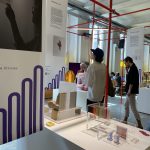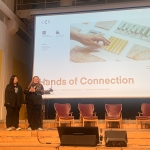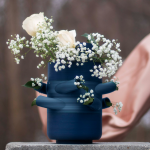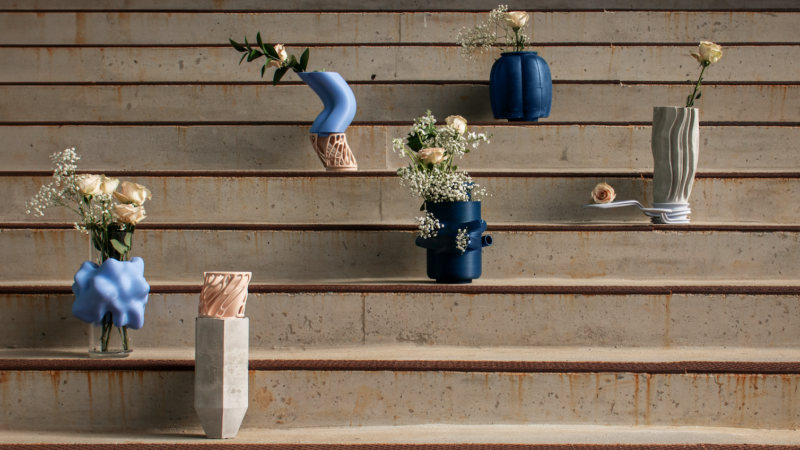Salone del Mobile, also known as Milan Design Week, serves as the most prestigious and pivotal venue where design trends are observed and set. Founded in 1961, the annual furniture fair has grown to become the largest in the world, with more than 1,950 exhibitors showcased over a space of 210,000 square miles, and 360,ooo visitors this year.
In addition to the formal trade show, Design Week takes over the entire city with a collection of events, installations, lectures, and pop-ups which are held in showrooms, galleries, and public spaces throughout the month of April.
It is the place for designers to present, and this year, two Detroit institutions were asked to join.
Four students from the College for Creative Studies attended with Sandra Olave, Chair of the Interior Design Department, and Melanie McClintock, Associate Professor and Chair of the Color and Materials Design Department in the Graduate Program. Six students from Lawrence Technological University’s Product Design program were invited to present their work and four of them attended with B. Nur Saltik, Assistant Professor + Director of Product Design.
“The opportunity to showcase their work on an international platform such as Milan, make connections with other designers from around the world, and gain this experience is absolutely invaluable for these students’ careers,” said Olave.

CCS MODEL SPACE
“The whole world is watching Milan Design Week, and exposing these students and Detroit to that is huge,” said Saltik.
The opportunity for the College for Creative Studies to attend and present ultimately came through the school’s connection with Cumulus, and via that, the Domus Academy.
The Domus Academy selected seven institutions to be part of their presentation UNFOLD, which pushed the designer’s abilities to interpret the complexities of interconnections through simple design, capable of generating a positive impact.
“CCS has a partnership with CLASS Agency so the theme of UNFOLD aligned well with us,” said Olave. “This real-world connection to a local community is what emotionally connected the students to this project.”

CCS PRESENTS
CCS students and faculty presented two projects; Hands of Connection and Site of Self. These projects were outcomes of a course in which students designed a mixed-use commercial/residential space for CLASS Agency to support the healing process.
Hands of Connection involved hand-made ceramic, wood, and brass structures incorporating a unique use of textiles. Students used tactile materials for the community to find their way and find comfort throughout the spaces.
The Site of Self project focused more on engagement and using design to facilitate positive mental and emotional impact. The students used healing colors and transparency, partitions, and textiles to develop respite rooms and spaces that allow individuals control and expression within the space.
“This whole experience pushed the students harder than they’ve ever been pushed within a course and that’s a learning experience in itself,” said McClintock. “There was so much work invested leading up to the event and behind the scenes, and you could feel it and see it in all of the outcomes.”

LTU COLLECTION
“I’ve been working to get students to Milan for two reasons,” she said. First, exposing the students and Detroit to the world of design and what others are doing is invaluable. Second, it’s a platform the world watches and it helped to put the students, the school, and the city of Detroit in the spotlight.”
LTU students were invited to show their projects as part of the ISOLA Design Gallery. The project came out of a new class Saltik developed called Curious Objects and Connections, in which students were tasked to design objects that stack and create them through manufacturing methodologies, technology, and contemporary techniques. “The intent was to develop a relationship between the objects and think about what a collection means together,” said Saltik.
Ten pieces in three stacks were exhibited including crystalized storage units, concrete cast pieces, and more.
When asked what the students gleaned from the experience, the faculty of both institutions had unique yet similar perspectives.
“I think the students learned problem-solving and connection to a goal,” said Olave. “They also needed to be able to convey trends quickly and transfer information quickly and these are important skills.”
Saltik weighed in, saying, “Through this experience, the students were able to understand that their work is justified and valued on a global scale,” she said.
“The students had to apply extreme time management skills,” said McClintock. “In addition to the project itself, they had to write a 2000-word paper and to tell their story to an international audience at a show consisting of millions. There was so much involved, they had to meet deadlines outside of deadlines.”

LTU PIECE
McClintock also said there was a unique opportunity for the students to be able to change perceptions about Detroit. “They asked the audience what came to mind when thinking about Detroit and the answers were: abandoned buildings, blight, and crime,” she said. “The students told the audience that they think the opposite – they see Detroit as a strong, resilient, creative community.”
Now that the 2024 Design Show is behind them, the faculty members regroup and also look to the future.
“This was and is about educating a new generation to lead the design economy in Michigan and beyond,” Saltik said.
“The academic value of this experience is important for their future careers,” said McClintock. “But the soft skills in terms of communication and preparation and confidence will take them even further.”
In the end, it’s clear that these professors invested energy, work, passion, and compassion to ensure these students were able to gain this experience.
“The project was emotional and so much effort took place behind the scenes,” said McClintock. “We saw it in the students … the emotion, the exhaustion, and the resilience and the learning.”
As always, be sure to subscribe to our newsletter for regular updates on all things Detroit.






















